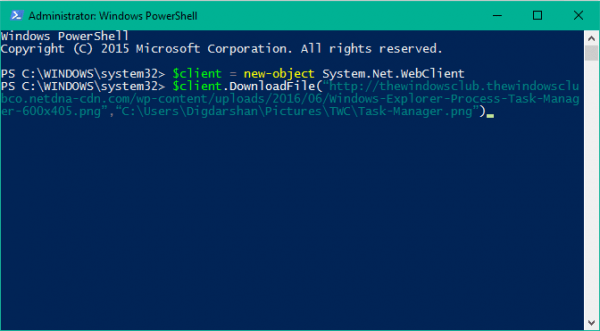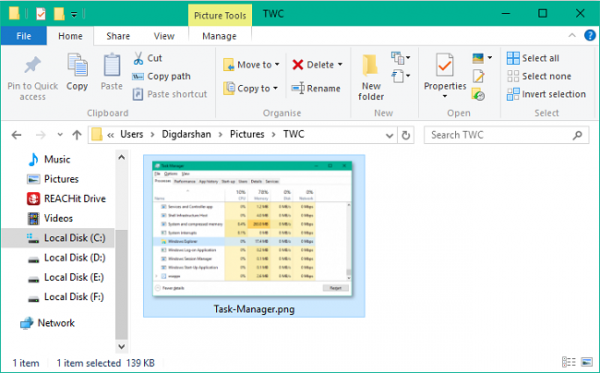Use PowerShell to download any file on Windows 10
Windows PowerShell is a tool built into Windows 10. This tool has the ability to set up more features than Command Prompt, better operating system control . Most likely, PowerShell will replace Command Prompt in the future.
Microsoft has developed PowerShell for the purpose of automating tasks and configuration management processes. Based on the .NET Framework, PowerShell includes a command line interface and scripting language.
How to use PowerShell to download any file?
To download any file on Windows 10 using PowerShell, follow the steps below:
1. Open PowerShell under Admin. To do this, press the Windows key, then enter powershell in the Search frame. On the search results list, right-click Windows PowerShell (Desktop App) and select Run as administrator.
In the UAC popup window, click Yes.
2. Next copy the link of the file you want to download using PowerShell.

3. Copy and paste the following command into Notepad:
$ client = new-object System.Net.WebClient
$ client.DownloadFile ('Download Link', 'File Destinationfile name.file extension')
4. In the above command, replace Download Link with the link you copied in step 2. Insert the location path to download the same file name you want to save with the extension to replace the Destinationfile name.file extension .
Such as the example below:
$ client = new-object System.Net.WebClient
$ client.DownloadFile ('http://thewindowsclub.thewindowsclub.netdna-cdn.com/wp-content/upload/2016/Windows-Explorer-Process-Task-Manager-600x405.png','C:UsersDigdarshanPicturesTWCTask-Manager. png ')
5. Copy the command you have finished editing in the previous step, paste it into the PowerShell window and press Enter to download the file.

6. You can now navigate to the download folder path to find the downloaded files stored here.

If you download any file, you need to enter some other information such as server login details, . then you can use the following command to download the file:
$ client = new-object System.Net.WebClient
$ client.Credentials = Get-Credential
$ client.DownloadFile ('http://thewindowsclub.thewindowsclub.netdna-cdn.com/wp-content/upload/2016/Windows-Explorer-Process-Task-Manager-600x405.png','C:UsersDigdarshanPicturesTWCTask-Manager. png ')
Refer to some of the following articles:
- 10 PowerShell commands help you manage the remote computer most effectively
- Add the 'Open PowerShell here' option to the context menu in Windows
- 10 new features in Windows Server 2012
Good luck!
You should read it
- PowerShell command in Windows
- What is PowerShell Basic commands in PowerShell
- How to install PowerShell 7.0 in Windows 10/8/7
- How are Command Prompt (cmd) and PowerShell different?
- How to use PowerShell's default parameter to change the command behavior
- Instructions on how to use PowerShell in Windows Server 2012
- How to check PowerShell version in Windows 10
- What to do when Windows can't find PowerShell?
May be interested
- Microsoft Windows PowerShell and SQL Server 2005 SMO - Part 11
 part 10 of this article series showed how to use powershell scripts in conjunction with smo and parameters to create sql server scripts. in this section, we will show you how to use powershell cmdlets in conjunction with the sql server client and output saving to export to a text file or xml file.
part 10 of this article series showed how to use powershell scripts in conjunction with smo and parameters to create sql server scripts. in this section, we will show you how to use powershell cmdlets in conjunction with the sql server client and output saving to export to a text file or xml file. - Next time, Microsoft will release PowerShell updates via Windows Update Windows
 microsoft is making it easier to update powershell on windows 10 and windows server devices by releasing updates via microsoft update in the future.
microsoft is making it easier to update powershell on windows 10 and windows server devices by releasing updates via microsoft update in the future. - How are Command Prompt (cmd) and PowerShell different?
 windows 7 has added powershell, a more powerful command line and script language. since windows 7, powershell has become more prominent, even becoming the default choice in windows 10. how is it different from command prompt?
windows 7 has added powershell, a more powerful command line and script language. since windows 7, powershell has become more prominent, even becoming the default choice in windows 10. how is it different from command prompt? - How to use PowerShell's default parameter to change the command behavior
 many people like to use powershell because it allows them to do things that can't be done with the windows gui. however, it is undeniable that some powershell cmdlets can be tedious or complicated. but what if there is a way to edit these cmdlets and get them to 'behave' the way you want?
many people like to use powershell because it allows them to do things that can't be done with the windows gui. however, it is undeniable that some powershell cmdlets can be tedious or complicated. but what if there is a way to edit these cmdlets and get them to 'behave' the way you want? - How to add 'Open PowerShell window here as administrator' to the right-click menu on Windows 10
 windows 10 comes with windows powershell 5.0. windows powershell is a task-based command-line shell and scripting language specifically designed for system administration. this tutorial will show you how to add or remove 'open powershell window here as administrator' on windows 10 right-click menu.
windows 10 comes with windows powershell 5.0. windows powershell is a task-based command-line shell and scripting language specifically designed for system administration. this tutorial will show you how to add or remove 'open powershell window here as administrator' on windows 10 right-click menu. - 10 PowerShell commands help you manage the remote computer most effectively
 windows powershell is a command executive command system and script scripting language that you can use to manage your system. in the following article, network administrator will show you 10 powershell commands to manage your computer remotely effectively.
windows powershell is a command executive command system and script scripting language that you can use to manage your system. in the following article, network administrator will show you 10 powershell commands to manage your computer remotely effectively. - What is PowerShell Basic commands in PowerShell
 what is powershell basic commands in powershell. first of all, to understand it briefly, powershell is a command-line interface similar to cmd, it can do everything cmd can do and even more. powershell is gradually becoming the default
what is powershell basic commands in powershell. first of all, to understand it briefly, powershell is a command-line interface similar to cmd, it can do everything cmd can do and even more. powershell is gradually becoming the default - Should I use PowerShell or Command Prompt?
 for advanced windows users, the command line has long been a powerful tool for managing and interacting with the operating system. but powershell offers enhanced automation and scripting capabilities. so which tool should you use?
for advanced windows users, the command line has long been a powerful tool for managing and interacting with the operating system. but powershell offers enhanced automation and scripting capabilities. so which tool should you use? - Steps to disable PowerShell in Windows 10
 if you do not often use powershell, disable and disable powershell to ensure the safety of your computer.
if you do not often use powershell, disable and disable powershell to ensure the safety of your computer. - Microsoft officially removes PowerShell 2.0 on Windows 11
 microsoft has completely removed powershell 2.0 from windows 11 preview builds.
microsoft has completely removed powershell 2.0 from windows 11 preview builds.










 How to speed up the display of right-click menus on Windows 10
How to speed up the display of right-click menus on Windows 10 All ways to open Windows Services on Windows 10/8/7
All ways to open Windows Services on Windows 10/8/7 How to open a file or an application on a virtual Windows 10 Desktop?
How to open a file or an application on a virtual Windows 10 Desktop? The configuration guide features the Quiet Hours on Windows 10
The configuration guide features the Quiet Hours on Windows 10 How to check and access UEFI settings on Windows 10
How to check and access UEFI settings on Windows 10